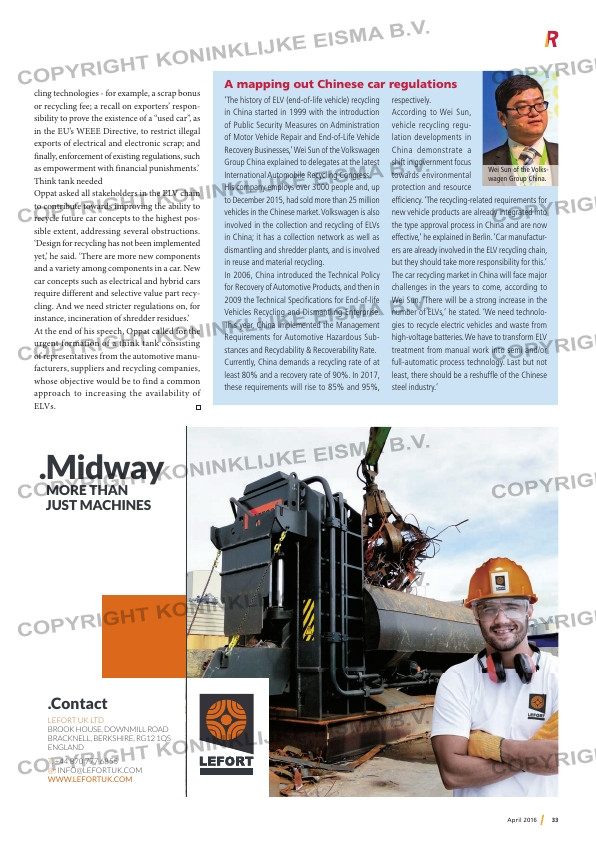Page 33 from: April 2016

33April 2016
cling technologies – for example, a scrap bonus
or recycling fee; a recall on exporters’ respon-
sibility to prove the existence of a “used car”, as
in the EU’s WEEE Directive, to restrict illegal
exports of electrical and electronic scrap; and
finally, enforcement of existing regulations, such
as empowerment with financial punishments.’
Think tank needed
Oppat asked all stakeholders in the ELV chain
to contribute towards improving the ability to
recycle future car concepts to the highest pos-
sible extent, addressing several obstructions.
‘Design for recycling has not been implemented
yet,’ he said. ‘There are more new components
and a variety among components in a car. New
car concepts such as electrical and hybrid cars
require different and selective value part recy-
cling. And we need stricter regulations on, for
instance, incineration of shredder residues.’
At the end of his speech, Oppat called for the
urgent formation of a think tank consisting
of representatives from the automotive manu-
facturers, suppliers and recycling companies,
whose objective would be to find a common
approach to increasing the availability of
ELVs.
.Contact
LEFORT UK LTD
BROOK HOUSE, DOWNMILL ROAD
BRACKNELL, BERKSHIRE, RG12 1QS
ENGLAND
T. +44 870 777 6855
@: [email protected]
WWW.LEFORTUK.COM
. Midway
MORE THAN
JUST MACHINES
PubMobileMidway_uk_EN_190x134.indd 2 29/10/2015 14:30:39
A mapping out Chinese car regulations
‘The history of ELV (end-of-life vehicle) recycling
in China started in 1999 with the introduction
of Public Security Measures on Administration
of Motor Vehicle Repair and End-of-Life Vehicle
Recovery Businesses,’ Wei Sun of the Volkswagen
Group China explained to delegates at the latest
International Automobile Recycling Congress.
His company employs over 3000 people and, up
to December 2015, had sold more than 25 million
vehicles in the Chinese market. Volkswagen is also
involved in the collection and recycling of ELVs
in China; it has a collection network as well as
dismantling and shredder plants, and is involved
in reuse and material recycling.
In 2006, China introduced the Technical Policy
for Recovery of Automotive Products, and then in
2009 the Technical Specifications for End-of-life
Vehicles Recycling and Dismantling Enterprise.
This year, China implemented the Management
Requirements for Automotive Hazardous Sub-
stances and Recyclability & Recoverability Rate.
Currently, China demands a recycling rate of at
least 80% and a recovery rate of 90%. In 2017,
these requirements will rise to 85% and 95%,
respectively.
According to Wei Sun,
vehicle recycling regu-
lation developments in
China demonstrate a
shift in government focus
towards environmental
protection and resource
efficiency. ‘The recycling-related requirements for
new vehicle products are already integrated into
the type approval process in China and are now
effective,’ he explained in Berlin. ‘Car manufactur-
ers are already involved in the ELV recycling chain,
but they should take more responsibility for this.’
The car recycling market in China will face major
challenges in the years to come, according to
Wei Sun. ‘There will be a strong increase in the
number of ELVs,’ he stated. ‘We need technolo-
gies to recycle electric vehicles and waste from
high-voltage batteries. We have to transform ELV
treatment from manual work into semi and/or
full-automatic process technology. Last but not
least, there should be a reshuffle of the Chinese
steel industry.’
Wei Sun of the Volks-
wagen Group China.



